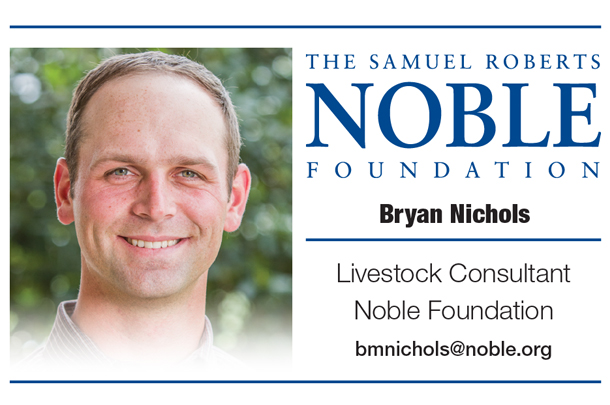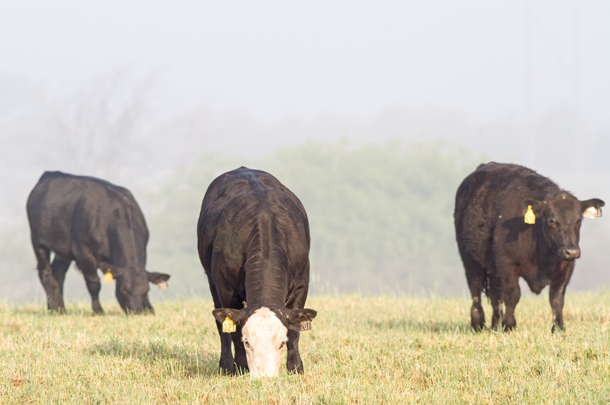The main value added to these cattle is weight gain. While different stocker operators enlist different strategies, many people make money in the stocker business by taking small sets of cattle that have been discounted for some reason and putting them into larger, more uniform groups.
Unlike a cow-calf operation, where cows are viewed as a long-term investment, the stocker cattle industry runs on a much shorter time frame. Generally, the longest anyone will own a stocker calf is eight months, but it can be as short as two months.

Advantages to managing stocker cattle is the flexibility to respond to changing conditions, such as drought, because it is designed for animals to come and go relatively quickly. On the other hand, because it is a short-term “bet” in the marketplace, the business is extremely susceptible to market fluctuations.
Facets of stocker cattle management
Successful stocker operators are those who pay attention to all facets of the business. Primary components include health, nutrition, stockmanship and marketing. All deserve due diligence.
Health
The foundation of a good health program is a relationship with a veterinarian and knowledge of the cattle’s history. It is important to know as much as possible about the cattle, including how far they were trucked and how they were managed, along with their nutritional and vaccination history.
Many times, no information accompanies the cattle, but the more the operator knows, the better. This information can then be discussed with a veterinarian to develop the proper health protocol.
This protocol should address any necessary vaccinations, deworming, metaphylactic antibiotic use and disease testing, such as persistent infection of bovine viral diarrhea (PI-BVD).
It should also address management of individuals that become sick. Timely treatment of sick animals is crucial. There is a small window of opportunity where calves readily respond to treatment and get better. Morbidity and mortality can greatly influence profits.
Nutrition
Nutrient-dense and palatable feedstuffs are critical for receiving stocker cattle, especially for high-risk cattle. The producer’s goal is to put weight on the cattle in the most cost-effective manner. Generally, as individual animal gain increases, the money it takes to put on that weight decreases.
However, this should always be analyzed given current resources and feed costs. In grazing situations where optimizing gain per acre is the ultimate goal, this may not always hold true.
Stockmanship
Stocker cattle management is generally not well suited to a part-time operator. In stocker enterprises, decisions have to be made in a timely manner. Because it is a short-term enterprise, there is no time built in to recover from a management mistake. To be successful, a stocker operator needs to understand the intricacies of the business, the marketplace and the cattle.

Small things such as shrink can make a difference. For example, if the average shrink on a load of 800-pound cattle is 2 percent, and an operator can reduce that to 1 percent, the operator has added $8 per head with value of gain at $1 per pound. In the stocker business, details make or lose you money.
Marketing
Marketing is a key component of stocker cattle enterprises. A marketing plan should be developed hand in hand with the management plans. An understanding of the markets is essential.
Learn as much as possible about typical market cycles and risk protection options. Now, more than ever, the market can fluctuate significantly day to day, and producers cannot rely on what they think they know.
To succeed in the marketplace, an operator has to understand what the cattle are worth on the front and back end. They also have to understand their own risk tolerance and prepare to mitigate that risk.
Stocker cattle by the numbers
The stocker cattle business is a margin business. The difference between the purchase price and selling price is the margin of profit. The trick is not paying too much for the calf on the front end, putting weight on the calf in a cost-effective manner in the middle and understanding and protecting the value of the calf in the future. To do this, it is important to understand some key terms. These are breakeven, cost of gain and value of gain.
Breakeven
Breakeven is the price at which the owner of the cattle does not make or lose money. A breakeven can be calculated on the purchase price and the sale price. One of the biggest considerations is buying cattle at the right price so producers can hit their projected end point.
With a given profit goal in mind, calculate what can be paid for the animal by looking at costs that go into adding value to the animal and what the projected sale price for the animal is. Calculate backward from the end point to find the answer.
The key is being honest about the cattle’s current value, the real costs associated with the cattle and the cattle’s future value. Calculate the sale price breakeven by knowing how much money is invested in getting the calf to the sale weight and what price they must receive to recover all costs.
Cost of gain
Cost of gain is the amount of money spent per calf divided by the total pounds gained. What an operator includes in a measure of cost of gain can be different depending on the operation. Include everything that is relevant to your specific operation. Obvious costs include medicine, feed (grazing or purchased feed) and labor.
Other costs can include opportunity cost, facilities, equipment and interest. The goal is to put as much weight on as efficiently as possible while keeping the cost as low as possible.
Value of gain
Value of gain is the amount of money the market pays for each additional pound of weight the animal gains. For example, if a 500-pound steer is worth $1,000, and a 600-pound steer is worth $1,100, the difference is $100. Divide the difference in value by the difference in weight ($100 / 100 pounds = $1 per pound of gain). If the value of gain is greater than the cost of gain, then an operator is making money on that animal.
Final thoughts
The stocker business is like any other business; it is about taking advantage of opportunities. To do this, operators must understand their capabilities and skill sets, have a plan and execute that plan. ![]()
PHOTOS: Nutrient-dense and palatable feedstuffs are critical for receiving stocker cattle, especially for high-risk cattle. Generally, as individual animal gain increases, the money it takes to put on that weight decreases. Photos courtesy of Noble Foundation.









